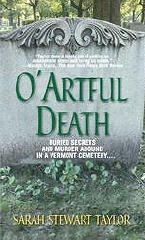September 2008
Monthly Archive
Tue 30 Sep 2008
LEWIS B. PATTEN – Lynching in Broken Butte.
Signet, paperback reprint; 1st printing, July 1975. Hardcover edition: Doubleday & Co., 1974.
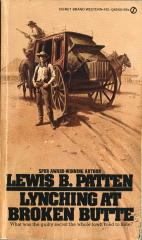
My review of Prodigal Gunfighter on these pages a short while ago was preceded by a post on Western Noir in which Patten’s name came up in a major way. Both of these posts elicited a substantial number of comments, showing that Patten, for one, is a western author still being read, in spite of his death in 1981, and that the concept of noir and western fiction are not in the least way incompatible.
In fact, Lynching in Broken Butte is one of the books Chap O’Keefe reviews in the latest online issue of Black Horse Extra, in which Western Noir first came up for discussion. When I recently happened across a copy of the paperback edition, I immediately set it aside to read.
Which when I did, took me just over an hour, even though it’s 172 pages long. As is common in Patten’s work, the action in Lynching, omitting the flashback to the incident in question, takes place in just over a day in the life of the town, Broken Butte, so it’s easy to start in on page one and keep on reading. The story never stops, and neither does the reader.
Five months before the story begins is where it really begins, though. Two drifters are jailed and then hanged for raping and killing the 15-year-old daughter of the town’s leading figure, Eric Carberry. When the town learns the next day that the two men were innocent, guilt hangs heavy over all their heads, and it comes to a boil when a US Marshal named August Cragg accidentally chooses Broken Butte as a place to stop over night while on other business.
And thirty hours later, all hell has broken loose. (I may be off on the number of hours. It’s certainly less than two days later, but longer than one, and I am correct on calling it hell.)
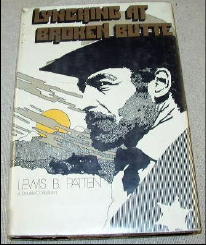
The ending comes a little too abruptly for me. With the town sheriff and Clara Easterday and her daughter Nan being held hostage, Cragg finds he has very few options, and makes do with really the only good one. Subtlety does not count in situations like this.
But as a short and incisive morality play, Lynching at Broken Butte fits the bill very nicely, nor does Patten seem to care very much about political correctness. Except for one or two individuals, there are no shades of gray, but those couple of individuals stand out for their conflicted motivations, particularly Sheriff Jasper Horsley, whose innate weakness allowed the lynchings to take place in the first place. Noir? Yes. Indubitably.
One thing does bother the backside of my brain, though. Soon after the lynchings, the true killer of Eloise, Carberry’s rebellious young daughter — a local townsman — is identified, convicted in court, and executed. If I had been he, I’d have threatened to make a fuss about the lynchings. He must not have had a very good lawyer. With a guilty secret like this hanging over the town, it sounds like a deal in the making to me.
[UPDATE] 10-01-08. Here’s how I’d cast the film made from this novel, subject to some second thoughts tomorrow:
Marshal August Cragg – John Payne
Clara Easterday – Peggy Castle
Sheriff Jasper Horsley – Lee J. Cobb
Eric Carberry – Ed Begley
Tue 30 Sep 2008
In my review of Sarah Stewart Taylor’s book Judgment of the Grave, in the post just preceding this one, I referred to it as noirish, but truth be told, the word surprised me when I wrote it. It came out naturally, but believe it or not, calling the book “noir” hadn’t occurred to me until that very moment.
It’s really a detective story with darker than usual overtones, and it’s very possible that Ms. Taylor had nothing more than that on her mind when she wrote it. So I’ve been puzzling it over. Why did my subconscious take over like that?
Is the book noir? Probably not, but I said in my original comments, with a slight but deliberate change of focus and intent, it could have been. (The marketing efforts were probably along the lines of it being an academic cosy.)
But continuing in the direction I was thinking, since I mentioned a black-and-white film version, I’ve come up with a possible cast, if the movie were to have been made back in the 1950s:
Sweeney St. George – Ruth Roman
Tim Quinn – Dane Clark
Ian (Sweeney’s friend in England) – Zachary Scott
Beverly Churchill (the missing man’s wife) – Beverly Garland
Cecily Whiting (mother of the boy with leukemia) – Mercedes McCambridge
Bruce Whiting (divorced from Cecily) – Robert Ryan
Lauren Whiting (Bruce’s new wife) – Gloria Grahame
George Whiting (Bruce’s father) – James Whitmore
Will Baker (local innkeeper) – Raymond Burr
With a cast like that, there’d be no doubt. Not so?
Sun 28 Sep 2008
SARAH STEWART TAYLOR – Judgment of the Grave.
St. Martin’s; reprint paperback; 1st pr., Aug 2006. Hardcover edition: St. Martin’s; July 2005.
It is impossible to keep up. When I go looking for whatever book to read next, I often pick one out at random, and invariably it’s the second or third in a series, almost never the first. (I used to teach college courses in probability, so I’m not complaining. I know exactly what the odds are, and they’re against me.)
Judgment of the Grave is the third of four of the recorded adventures of Harvard-based art historian, Sweeney St. George. It’s early in this review, instead of at the end, where I often do it, but here’s a list of all four. All came out first from St. Martin’s in hardcover, then in paperback:
O’ Artful Death. 2003 / June 2004.
Mansions of the Dead. July 2004 / May 2005.
Judgment of the Grave. July 2005 / Aug 2006.
Still As Death. Sept 2006 / Oct 2007.
And in spite of excellent reviews and good sales rankings on Amazon, these four appear to be all there’s going to be. Sarah Stewart Taylor’s website does not seem to have been updated since October 2007 and the last entry in her blog is dated May 2, 2007.
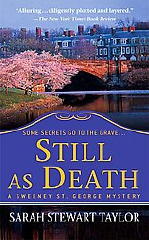
That’s a shame. In spite of some quibbles which I’ll get to shortly, I enjoyed Judgment of the Grave quite thoroughly. So well, in fact, that if I knew where my copy was, I’d read Still As Death next, just to find out what happens to Sweeney and her romantic difficulties in her followup adventure. And failing that, go back and read one or both of the first two (see above), just to learn how all of her romantic difficulties began in the first place.
Quibbles: These very same Sweeney’s romantic difficulties — and all of the problems the other characters have in Judgment of the Grave. They’re a major part of the story, and they tend to overpower the detective story involved.
But what they also help create is a dark, atmospheric tale filled with angst, anxiety and sorrow, beginning with the opening scene (after a short prologue) in which Sweeney meets a young 12-year-old boy with leukemia while she’s researching gravestones in a Concord MA cemetery.
Cambridge police detective Tim Quinn, whom Sweeney has met before and seems to have a history with, meets her again as he follows up on a missing person’s report — a professor having a similar interest in gravestones and the history of the Revolutionary War has disappeared after taking part in a battle re-enactment up near Concord. Quinn’s wife committed suicide, we learn, and he’s forced to take his 10-month-old daughter along with him. Sweeney is a multi-tasker. She babysits and helps solve the mystery at the same time.

Meanwhile Sweeney’s almost-but-not-quite-affair with Ian has been put on hold while he’s home in England. Phone calls every night. I don’t quite understand where Toby fits in, but he somehow seems to have overnight privileges.
Also often crowding the mystery aside are long expository pages on the War of Independence, how it was conducted, how not all of the colonists were fighting for freedom, and how much the British depended on spies.
The latter may be the reason for the present day killings, or perhaps not, because all of the other character’s marriages are either broken or on the verge, and jealousy or revenge are also excellent reasons for murder. A veritable Peyton Place, without the same degree of notoriety or sensationalism.
I suppose you already know, having gotten this far, whether or not you will ever read any of the books in the series, but nonetheless, with a bit of pruning down and firming up, and filmed in black-and-white, or with dark, shadowy indoor scenes contrasted with the bright colors of an autumn New England sky, Judgment to the Grave would be as noirish as they come. It’s not Los Angeles, but there are a lot of dark secrets in Massachusetts too.
[COMMENT.] Later the same day. I’m embarrassed to point this out, but while searching for some more information about the author on Google, I discovered that I’d totally forgotten that Walter Albert reviewed this same book here on Mystery*File, and not too long ago.
He liked it too.
Sat 27 Sep 2008
I received the following email from Mike Chomko yesterday with some startling but not surprising news. Here it is in its entirety:
Following the 2008 Pulpcon, I came home with a feeling of hope that things were finally going to change and Pulpcon would start reversing its recent losses. Now, nearly two months later, that feeling of hope is gone.
For a number of years, Jack Cullers, Barry Traylor, and I have been pushing for changes in the way that Pulpcon is run. For years, our pleas have been countered with “that’s the way we’ve always done things.” Following two lengthy committee meetings at the 2008 Pulpcon, Jack, Barry, and I seemed to get enough concessions out of the other committee members to feel that the convention was finally going to be run in new ways.
At the general business meeting held at this year’s Pulpcon, one idea that was discussed was finding a new site for the convention. Most members in attendance seemed to favor remaining in Ohio, but in a city other than Dayton.
About two weeks after returning from the convention, I took it upon myself to contact the cities of Cincinnati, Cleveland, and Columbus. All three municipalities responded, but Columbus was by and large the location that demonstrated the most interest in hosting our convention.
Needing some information for Columbus to put together a proposal for hosting Pulpcon, I contacted Bob Gorton, the chairman of the Pulpcon Committee. Bob provided the required information, but also stated he felt that it was time to renew the contract that Pulpcon had with the Dayton Convention Center.
I forwarded Bob’s email to the rest of the Pulpcon Committee-Richard Clear, Jack Cullers, Don Ramlow, Mary Ramlow, and Barry Traylor. The result of my email was a vote to renew the contract with Dayton (with Jack, Barry, and myself dissenting) and a reprimand from Bob Gorton. He told me that he was unaware that I had made a motion to call for a vote whether or not to stay with the Dayton Convention Center. I was simply trying to get things done quickly and responsibly.
At this summer’s committee meetings, Bob Gorton told us he is “not very good with email.” He said that he “largely ignored most email.” However, he agreed to “meet” via email at least once a month. The committee decided to hold a meeting via email on the first weekend of every month. We could contact each other via email at other times, but the monthly meetings would be required.
Our first email meeting was held over Labor Day weekend. To start our discussion, I combed through the Pulpcon business meeting minutes and the minutes from our two committee meetings, and wrote what I thought should be done concerning a wide array of items. I asked the use of volunteers, venues in which to advertise, conventions where we should have flyers, links to other websites, an explanation addressed to the general pulp community explaining why Pulpcon was returning to Dayton, changing the types of material that can be sold at Pulpcon, showing movies at the convention, obtaining mailing lists, newsletter revisions, a survey of Pulpcon attendees, and other things. I also suggested that with all the work to be done, we should be communicating more than once a month.
The responses to my queries and ideas were practically nil from Gorton, Don Ramlow, and Richard Clear (who was new to the Pulpcon Committee).
Since that first email meeting, Bob has been silent, not communicating with Jack, Barry, or me. I do not know if he is communicating with anyone else. Don has emailed a few suggestions, as well as Mary. Richard Clear has likewise made a few comments. But for the most part — except for fairly constant communications between Jack Cullers, Barry Traylor, and myself — the Pulpcon Committee has largely been silent.
In fact, in a recent email to the entire committee, Don Ramlow wrote: “I know everyone has their own responsibilities. However, my schedule is the busiest in the fall. I’m setting up 12 radio productions for my theatre group All Ears theatre, teaching five colleges classes (one which is on-line requiring a lot of email contact), working with other people on other conventions, trying to find time to practice with my rock band “Chaos Theory” and finally finish up my 200,000 word reference book on OTR so I can submit it to the publisher yet this year. That, in addition to finding time to spend with Mary and our children and grandchildren. I realize that my schedule is not of concern to others and that you all have your own commitments. However, for me it means trying to budget time for all of them and the only way I can do that is to schedule accordingly.”
When asked this week about preparing advertising flyers for Gary Lovisi’s book show, Bouchercon, and Rich Harvey’s Pulp Adventurecon, Gorton and Don Ramlow did not respond.
Given Bob Gorton’s silence and Don Ramlow’s suggested lack of time to commit to the work required to turn Pulpcon around, I asked them to resign from the committee. Both Jack Cullers and Barry Traylor seconded my motion. Unfortunately, both Gorton and Ramlow have ignored my request.
Jack Cullers, Barry Traylor, and I have decided that if we want to move the convention forward, it is impossible to continue to work with Bob Gorton and Don Ramlow. They seem to feel that shortening the convention to three days will be enough to turn things around. They seem to think that by creating a few generic flyers that seem to be addressed to people who already know about Pulpcon, the convention’s troubles will be over. They seem to think that they need to devote very little time and energy to turn Pulpcon around. They seem to think that communication is unnecessary.
Although it’s time for Gorton and Ramlow to step aside so progress can be made, they do not appear to be willing to do so. Jack Cullers, Barry Traylor, and I are willing to devote the time and energy needed to get Pulpcon moving forward. However, we cannot do so with the obstructions set up by Gorton’s inability to communicate and Ramlow’s lack of time and cooperation. We have therefore decided to break away from the Gorton/Ramlow convention and organize our own Pulpcon.
This past June, Jack Cullers learned that the Pulpcon service mark, originally registered to Rusty Hevelin, had lapsed in 1989. So Jack applied to register the service mark in his own name. The United States Patent and Trademark Office is currently investigating Jack’s claim to the service mark. Jack, who has been a member of the Pulpcon Committee for many years, believes there should be no difficulty in registering the service mark in his own name.
Jack, Barry, and I are currently investigating sites in Columbus, Ohio for a planned Pulpcon to be held in late July or early August, without the obstructionists Gorton and Ramlow. We are also in discussions with interested parties who are considering holding an East Coast pulp and paper convention, most likely in November 2009.
Whenever we hold the convention, we plan to publicize it and open it up to a wider array of material than has traditionally been allowed at Pulpcon. However, if we are to organize a successful convention, we will need your help. Please plan to support our convention in whatever month it is held.
If you are a dealer and would be interested in selling at our show, please let us know as soon as possible. If you are interested in lending a hand, please drop us a line. More particulars will follow as our plans become better defined.
If you’d like to be added to the new Pulpcon mailing list, please send your name and address to Mike Chomko at michaelchomko@rcn.com or 2217 W. Fairview Street, Allentown, PA 18104-6542 or Jack Cullers at jassways@woh.rr.com or 1272 Cheatham Way, Bellbrook, OH 45305. Please be sure to include your email address if you have one. Thanks.
Sat 27 Sep 2008
DIG ME LATER – Miriam-Ann Hagen.
Mercury Mystery 157; digest-sized paperback; no date stated, but generally accepted as being 1951. Hardcover edition: Doubleday/Crime Club; 1949. Hardcover reprint: Detective Book Club, 3-in-1 edition, August 1949.
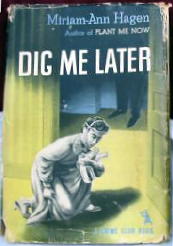
I mean no offense to anyone named Hortense, or who knows anyone with the name Hortense, but it IS an old-fashioned name, I believe you have to admit, and a series of mysteries with a leading character named Hortense Clinton is going to be considered light-hearted from the outset, whether it is true or not.
But true it is, or at the least, this second of three mysteries she was involved in certainly is. When a murder occurs across the hall to her in her Manhattan apartment, Hortense accidentally confronts the killer with her night clothes on, blemish cream on her face, chin strap on, and a band across her forehead.
Of course squatting down on the floor as she was, all she could see before she was knocked unconscious was the killer’s pant legs and shoes. But if the killer was the dead man’s nephew making his getaway as she was putting her milk bottles out, why did he take the time to take her diamond watch?
As it happens, the answer to that question is clear to any reader who’s been paying attention and has read Chapter One carefully, so anyone who reads detective stories for the detective work in them isn’t going to find much of any substance to mull over in this one.
But the characters are what might keep you reading, as the did me, somewhat wacky and somewhat confusing, or confused themselves as to why so many of them end up with Hortense in a resort hotel in Nova Scotia where she flees when her notoriety in Manhattan proves to be too much for her.
The killer is obvious enough in retrospect, but there are plenty of false trails to be followed and examined carefully before the final denouement. Most – but not all – the questions are answered, and Hortense Clinton survives to be involved in another murder another day. (See the bibliography below.)
But before getting to that, I didn’t do any research on the author before beginning the book – I seldom do, as I prefer to let the book speak for the author, not his/her reputation or background. I almost never even read the blurbs on the jacket flaps or the back cover.
So it took me a while to place Ms. Hagen’s style of writing, even though I have to admit that I should have known. It’s a style that feels itself necessary to explain the smallest detail, to spell out things so that the reader will fully understand, and yet is smooth enough, and clever enough to stay interesting. I am not denigrating it in any way. It’s a style of writing I most certainly and definitely admire.
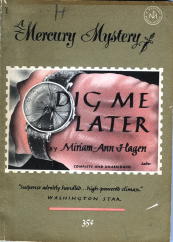
I wish I could explain better what I mean, but here’s a sample, and maybe that will help. Picking a page and a selection at random from the first chapter, take this as an example. Hortense is being asked by the police to identify the nephew’s shoes:
Although she wouldn’t raise her eyes above the feet she was asked to identify, she had a feeling that the simple monosyllable had been a blow to the young man and that he had stiffened under it. “Yes,” she repeated hastily, “like this man’s or like most men’s. You could go out in the street and within ten minutes bring in a hundred men, and I’d look at their feet and have to say yes, about that size.”
“Sure, Miss Clinton,” said the detective. “Sure. We don’t expect you to say it was this man’s feet you saw. That would be asking too much. We just want you to tell us if it could have been this man’s feet, that the ones you saw weren’t so much bigger or smaller or anything that you’d know they couldn’t have been his or even that you’d think maybe they couldn’t be his.”
They worked at it, trying to pin her down to some sort of statement, but Hortense refused to say more that what she could say with certainty, until finally, in a burst of frankness, they told her exactly what they wanted of her, and to that she had to give them the answer that satisfied them….
Which was, to cut the story off short, that she wouldn’t later be able to testify in court that it couldn’t have been the man that the suspected of being the killer.
I don’t know if that was enough of a sample for you to tell, and maybe you never heard of Aaron Marc Stein, also known as George Bagby and Hampton Stone, but the writing is identical. But if you have, then I’m sure you spotted the similarity, and probably even before I made the connection. And if you’ve been paying attention to this blog, as I should have been, or at least my only claim for ignorance was that I forgot, in one of Mike Nevins’s columns for M*F, he happened to have mentioned in passing that Miriam-Ann Hagen was Aaron Marc Stein’s sister.
The title comes from a bit of jazzy jargon from the 1940s that I don’t think was used appropriately in the novel, but to expand the context a little, take a look at the three mystery novels that Miriam-Ann Hagen wrote, courtesy of Crime Fiction IV, by Allen J. Hubin:
HAGEN, MIRIAM-ANN (1903-1984)
Plant Me Now (n.) Doubleday 1947 [Hortense Clinton; Train]
Dig Me Later (n.) Doubleday 1949 [Hortense Clinton; Canada]
Murder-But Natch (n.) Doubleday 1951 [Hortense Clinton; Ship]
[UPDATE] 09-28-08. I asked Mike Nevins to read my comments and then to consider the possibility that Aaron Marc Stein might have written the Hortense Clinton books under his sister’s name. Here’s his reply. I’m sure he’s right, but the thought lingers on…
Interesting review! Aaron and Miriam were exceptionally close siblings, and you’re absolutely right that she modeled her style and structure on his. He must have read those books before publication and may have edited them a bit, but I have no reason to think he ghosted them for her.
Best,
Mike
Wed 24 Sep 2008
If you check back, it was a year ago yesterday that I announced here on the blog that I’d uploaded an article by John Pugmire about one of his favorite subgenres of mystery fiction, Locked Room Mysteries. (Mine, too, of course.)
It’s largely a list of such stories considered to be the best by a couple of noted panels of experts — I’ll leave the details to the article itself — along (and here is where I came in) with cover images of as many of them as John and I could come up with — or nearly 100 or so.
Some time ago — and longer ago than I’d rather admit — John sent me images of five more covers, one an improvement over one that we’d used to fill a gap, plus four that are brand new. I’ve finally gotten around to doing what I do, and that’s get them online at last.
The page is on the primary M*F website, and even if you’ve seen it before, I think it’s worth a look. Here’s the URL: https://mysteryfile.com/Locked_Rooms/Library.html, and here are a couple of the newly added covers:

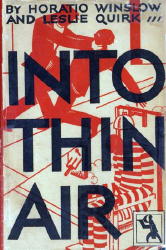
Tue 23 Sep 2008
Back in May it was that I posted an inquiry from John Herrington about some records in North Carolina that should shed some light, he thought, on the true identity of British mystery writer A. Fielding, until recently thought to be a pseudonym of Lady Dorothy Feilding, 1889-1935.
Catching up with what John’s learned since then, here are a couple of emails from him. From late July:
“Just to say that I have managed to get the University of North Carolina to check some of those Fielding/Feilding papers. The main thing is that she was still alive in 1946, which I believe kills off the Lady Dorothy angle — if not the fact that she was living, at least some of the time, in Belgium in the 1920s.
“I have an address for her in Staffordshire in 1945 and 1946, and am trying to see if I can trace her there.
“It is interesting that she does not seem to have a permanent address. From 1925 to 1946, she seems to have had 10 addresses, some of them hotels or forwarding addresses like banks.”
More recently, here’s an email from John that reached me a couple of days ago:
“I have sent Geoff Bradley a review of what I know, which should appear in the next
CADS. Basically, I now know she was in Belgium in the late 1920s and in a rest home in Staffordshire at the end of WW2.
“Her birth, marriage and death are still a mystery. But there is a possibility that I may have found her marriage — but I need to prove the husband’s name is misspelled as Fielding in the records. (…) I also believe she had the middle initial of ‘M’, which she seems to have omitted later on. But it is all supposition till I can get certificates, etc.
“There is one other thing you might ask on Mystery*File. Out of curiosity I looked the birth of ‘James Hadley Chase’ up on Freebmd. He was apparently born René Lodge P. Brabazon Raymond. But Steve Holland has never discovered what the ‘P’ stands for, if it stands for anything. Just wonder if anyone might know.”
Just another reason for everyone with an interest in Golden Age and (mostly) traditional mysteries to anxiously await the next issue of CADS (short for Crime and Detective Stories).
Geoff Bradley, the editor, doesn’t maintain an online presence, but information about issue 50 can be found here. The issue most recently mailed is #54. His email address is Geoffcads @ aol.com
Mon 22 Sep 2008
It’s been a long time in getting it finished (the last update was sometime in January) but the Mystery House section of Bill Deeck’s Murder at 3 Cents a Day Lending Library website is ready for viewing. Thanks to the assistance of Bill Pronzini, whose collection has been of great use, cover images of almost all of the books published by Mystery House between 1940 and 1948 are now online.
Mystery House was revived as an imprint in 1952 and continued on until 1959, but rather than doing any of these, what Bill and I will be tackling next are the covers of the lending library mysteries published by Arcadia House between 1939 and 1947. Arcadia House also began publishing mysteries in 1952, but here again we’ll concentrate on the ‘Golden Age’ titles first.
Here are a couple of the Mystery House covers. For the others, you’ll have to follow the link above:
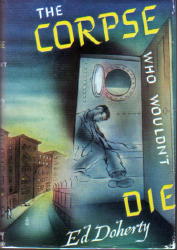
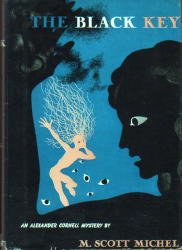
Sat 20 Sep 2008
To continue from my previous post, I saw my regular doctor on Tuesday, and she agreed to let me go back to the amount of Armour Thyroid I had been taking. She also went through a list of possible replacements for the endocrinologist whose assistance I no longer require. (Ha.) As it turns out, though, the name of the one I’ll be seeing next came from the patient standing behind me at the checkout desk.
Turns out that he and I have gone through pretty much the same list of doctors in the past, only he’s been way ahead of me in seeing this and that one and rejecting them all until he came to one he likes and who he says actually takes the time to talk to him.
Problem is, my appointment with this new fellow isn’t until mid-January. That’s how far backed up anyone specializing in diabetes or thyroid cases are, in case your son or daughter happens to be looking for a possible new career path.
But now I know — from the Internet, not from any doctor — that taking Armour Thyroid should be spread throughout the day, not just the morning, and that calcium supplements interfere with its effectiveness. So I’ve changed my pill-taking regimen accordingly, and while it’s too early to say for sure, so far it seems to have helped. But it is scary that you have to learn things like this on your own. You really have to wonder just how much doctors really know.
In any case, the bottom line is this. Don’t ever let your doctor’s goal be normal numbers. Let the goal be the normal health of the patient, and that folks, is you, someday if not now.
As for me, I’m alternating good days with bad days, which is a big step up from mostly bad ones. It took me a while to bottom out as I seem to have done, and it will probably take about as long to get back up again. Mystery*File as a blog won’t be shutting down, but its focus will change (again, as it has every so often) to — well, I haven’t quite gotten that far, but you’ll see, probably about the same time as I do.
I hope this will be the last time I need to talk about myself like this, but it certainly helps to have a forum like this where I can vent off every once in a while. Thanks again for all of the good wishes, suggestions and advice. I most certainly appreciate it!
Wed 10 Sep 2008
I’ve been ill the past few days. It seems strange that such a small gland such as your thyroid could be so crucial, but it is. It regulates your entire well-being.
As for the new endocrinologist, he’s history. We’ve come to an impasse. He called me on Monday after my latest set of blood tests and I’d told the nurse I’d like to talk with him, and he began by saying, “We can’t keep having this same conversation over and over again.” (This is the third time we’d talked, once in his office.)
He wanted me to cut back on my thyroid supplements even more, and I told him I was too ill to think about it. His reply, without once asking me what kind of problems I’d been having, “If you don’t take my advice, I can’t help you.” Go back to the previous dosage? Out of the question. “I won’t write you a prescription for it.”
As a say, an impasse, and he’s out of my life. I’ll see my primary care physician next week, and she’ll help me get things straightened out. That I’m not concerned about.
But things will remain quiet here on the blog for a while longer. I don’t know if you wanted to know all this, but you haven’t seen anything here from me lately, and I thought maybe I should tell you why.
I also needed to let off some steam, as you can imagine.
Next Page »


